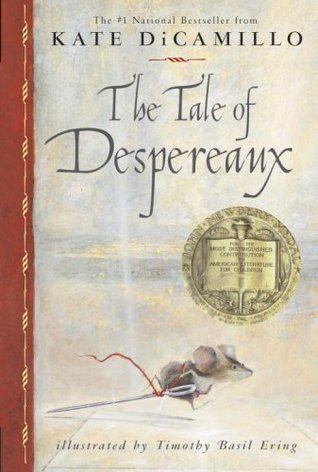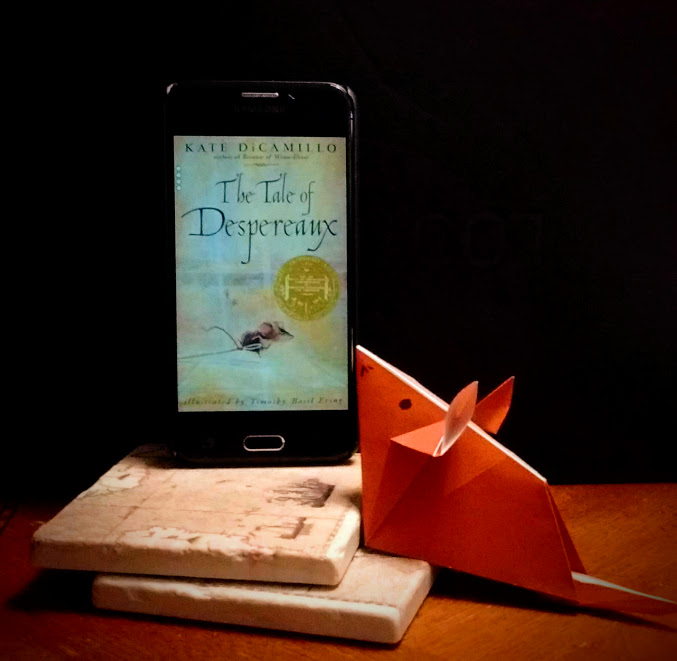Sometimes you hear about books for so long, it begins to feel you must have read them because everyone has read them…so you must have too, right? And then you try to remember a single detail from the book, and it turns out you can only remember what others have said. Kate DiCamillo‘s The Tale of Despereaux was like that for me.

My initial take away was that this story is clever. Clever use of names and word choices, clever ways of sharing small details, and clever use of narrative. That last one caught my attention in particular, because I generally find a narrator who speaks directly to the reader a bit grating. It feels to me like I’m sitting at a party hearing someone relate an exciting story about how they found themselves standing in front of a bus just as it bore down on them–and having the storyteller stop at the most exciting part and say ‘What do you think happened next?’ To which I want to irritably respond ‘I don’t know, why don’t you tell me?’ But the thing is, the narrative choice in this book is very wise. It not only adds to the feeling that the reader is sitting at the feet of the storyteller, hearing their insights and asides as the story progresses, but it leaves the reader with an enhanced sense of safety precisely because the listener is not alone with the story. The Tale of Despereaux covers some dark territory, and does it unflinchingly. But like the grim (ha!) fairy stories of old, the reader can face the darkness because they know they’re not alone. So, while adult readers and some children may find the narrative voice intrusive, I suspect for other children it allows them to walk a few feet into the darker parts of the story without getting lost, and in doing so face fears that would otherwise be too much for them.
The beautiful thing about it is that the narrative style and general cleverness don’t keep the book from having fully-fleshed out and loveable characters. This was true of our tiny mouse hero, Despereaux–so named because his mother found him such a disappointment at birth–the shining human girl Princess Pea and their foe in a certain covetous rat, but is also true of secondary characters such as the mouse threadmaster and Cook. In fact, Cook just may be my favorite character! She’s so solidly herself, with her hatred of all mice and her love of soup and serving the royal family. She’s far from perfect, but she’s the kind who would feed her worst enemy–as witness her eventual kindness to Despereaux. I love that in a book based on the grand patterns of ancient fairy tales, with knights (even mouse knights) and royalty, one could readily argue that it was the choice of a simple cook who made it all work out in the end. Fittingly, she does so without changing or intentionally taking part of the story at all. She’s just Cook, and that’s enough. In a story where small-minded people and mice nearly bring about great tragedy, it’s lovely to see someone who’s plain jane best is good enough to influence great things.
I fear I’ve shared my thoughts in a topsy turvy fashion…but so long as you’re intrigued and know this is a story of a tiny heroic mouse, a mean-spirited rat, a bunch of other folk, and a princess named Pea, you’ve got enough to go on and will probably enjoy it if you pick it up! Now, let’s see what Apricot-kitty thought of it:
 “You’re kidding, right? I’m afraid I very much side with the rats in this, and believe the best thing for that mouse was someone swallow him down in one gulp. And while we’re on the subject of dinner, the foolish king could have quickly rid his dungeon of rats if he’d brought in a few sturdy cats. We prefer mouse, but most of us would be happy to help him with his rat problem–and without any of that soup nonsense!”
“You’re kidding, right? I’m afraid I very much side with the rats in this, and believe the best thing for that mouse was someone swallow him down in one gulp. And while we’re on the subject of dinner, the foolish king could have quickly rid his dungeon of rats if he’d brought in a few sturdy cats. We prefer mouse, but most of us would be happy to help him with his rat problem–and without any of that soup nonsense!”
I really should have seen that coming. I guess it’s saying something, that for me the story transcended such mundane things as a cat’s typical relationship with a mouse. However, Apricot-kitty’s comments do remind me that I was not entirely comfortable with the author’s perspective on rats, and can’t imagine readers with beloved pet rats would care for the rather fixed perspective that rats are bad. That perspective is softened at the end…but I still would hold off on recommending this book to any readers with a soft spot for rats.
I put together a bookstagram pic for this story, complete with a not-so-little origami mouse I folded. Do you like it? And perhaps more to the point, should I name my mouse Goliath or pretend I shrunk my phone? I like to do things with my hands and have recently fallen in love with origami…but still have lots to learn! 😀

As a side note for those who’ve probably heard of Kate, I LOVED her novel Flora and Ulysses–spotlight on that here! For more of today’s Marvelous Middle Grade Monday spotlights, reviews, giveaways and interviews stop by Greg Pattridge’s blog, and happy reading!

Greg Pattridge
Suzanne
June McCrary Jacobs
Suzanne
Rosi Hollinbeck
Suzanne
Patricia Tilton
Suzanne
Iron Guy Carl
Suzanne
Joanne R. Fritz
Suzanne